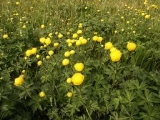
Globe-flower
Encyclopedia
The Globe-flower, Trollius europaeus, is a perennial plant
of the family Ranunculaceae
. The plant is native of Europe
and Western Asia and is a protected species in Bulgaria
.
up to 3 cm across. The colourful petaloid sepal
s hide 5-15 inconspicuous true petal
s with nectaries at their base and, typically for the family, a large number of stamen
s. Each flower produces a large number of wrinkled follicles
. The leaves are deeply divided into 3-5 toothed lobes.
It grows in damp ground in shady areas, woodland and scrub, flowering between June and August. It is slightly poisonous and is purgative and rubefacient
when used fresh.
This species is pollinated mostly by seed-eating flies belonging to the genus Chiastocheta (Anthomyiidae
).
Perennial plant
A perennial plant or simply perennial is a plant that lives for more than two years. The term is often used to differentiate a plant from shorter lived annuals and biennials. The term is sometimes misused by commercial gardeners or horticulturalists to describe only herbaceous perennials...
of the family Ranunculaceae
Ranunculaceae
Ranunculaceae are a family of about 1700 species of flowering plants in about 60 genera, distributed worldwide....
. The plant is native of Europe
Europe
Europe is, by convention, one of the world's seven continents. Comprising the westernmost peninsula of Eurasia, Europe is generally 'divided' from Asia to its east by the watershed divides of the Ural and Caucasus Mountains, the Ural River, the Caspian and Black Seas, and the waterways connecting...
and Western Asia and is a protected species in Bulgaria
Bulgaria
Bulgaria , officially the Republic of Bulgaria , is a parliamentary democracy within a unitary constitutional republic in Southeast Europe. The country borders Romania to the north, Serbia and Macedonia to the west, Greece and Turkey to the south, as well as the Black Sea to the east...
.
Description
Trollius europaeus grows up to 60 cm high with a bright yellow, globe-shaped flowerFlower
A flower, sometimes known as a bloom or blossom, is the reproductive structure found in flowering plants . The biological function of a flower is to effect reproduction, usually by providing a mechanism for the union of sperm with eggs...
up to 3 cm across. The colourful petaloid sepal
Sepal
A sepal is a part of the flower of angiosperms . Collectively the sepals form the calyx, which is the outermost whorl of parts that form a flower. Usually green, sepals have the typical function of protecting the petals when the flower is in bud...
s hide 5-15 inconspicuous true petal
Petal
Petals are modified leaves that surround the reproductive parts of flowers. They often are brightly colored or unusually shaped to attract pollinators. Together, all of the petals of a flower are called a corolla. Petals are usually accompanied by another set of special leaves called sepals lying...
s with nectaries at their base and, typically for the family, a large number of stamen
Stamen
The stamen is the pollen producing reproductive organ of a flower...
s. Each flower produces a large number of wrinkled follicles
Follicle (fruit)
In botany, a follicle is a dry unilocular many-seeded fruit formed from one carpel and dehiscing by the ventral suture in order to release seeds, such as in larkspur, magnolia, banksia, peony and milkweed....
. The leaves are deeply divided into 3-5 toothed lobes.
It grows in damp ground in shady areas, woodland and scrub, flowering between June and August. It is slightly poisonous and is purgative and rubefacient
Rubefacient
A rubefacient is a substance for topical application that produces redness of the skin e.g. by causing dilation of the capillaries and an increase in blood circulation. There is limited evidence as to their efficacy ; and as of 2010 the best evidence does not support using gels and creams...
when used fresh.
This species is pollinated mostly by seed-eating flies belonging to the genus Chiastocheta (Anthomyiidae
Anthomyiidae
Anthomyiidae is a large and diverse family of Muscoidea flies. Name came from Greek "anthos" + "myia" . Some species are commonly called "root-maggots", as the larvae are found in the stems and roots of various plants...
).

